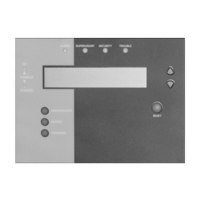Siemens Industry, Inc.
Building Technologies Division
P/N 315-048733-102
When the SSD-C is configured as Display only, pushbutton presses to any control
keys will not affect the logic of the system, but will silence the SSD-C audible signal
regardless of the position of the security keyswitch.
When the SSD-C is configured with System Control, the security keyswitch has to be
in the ENABLE position for the control pushbuttons (ACKNOWLEDGE, SILENCE,
UNSILENCE and RESET) to respond.
When the SSD-C is used in a No Vectoring application, all events that occur in the
system are displayed on the SSD-C. If the SSD-C is configured with System Control,
it can take full control of the system (Acknowledge events, Silence/Unsilence
Audibles and Reset the system).
Queue Vectoring displays only the specific event type(s) (Alarm, Supervisory, Security
and/or Trouble) that have been configured in the Zeus Programming Tool. Multiple
queues (Alarm, Supervisory, Security and/or Trouble) can be selected, but in Queue
Vectoring at least one queue is not selected. Selections are made in the Zeus
Programming Tool by deselecting any Display event type(s)—Alarm, Supervisory,
Security and/or Trouble—not desired in the queue. Refer to the Programming section
on page 7 for further information.
Acknowledgment Events display on an SSD-C in the priority order of Alarm, Supervisory, Security and
Trouble. An SSD-C with Queue Vectoring will display only those events for which it
has been configured and it can acknowledge an event only if the event is from the
highest priority queue with unacknowledged events. The ability of an SSD-C with
Queue Vectoring to display and acknowledge events depends on a combination of
the queue settings and the current events in the system.
• For example, an SSD-C that is configured to display only Alarms will be able
to acknowledge any alarms that exist on the system but will not be able to
display or acknowledge any Supervisories, Securities or Troubles that may
exist once the alarms have been acknowledged.
• An additional example is an SSD-C that is configured to display only
Troubles. If only trouble events exist on the system or if all higher priority
events are already acknowledged, then the SSD-C will be able to acknowl-
edge Troubles. However if there are any unacknowledged Alarms,
Supervisories and/or Securities, the SSD-C will not be able to acknowledge
the troubles until the alarms, supervisories and/or securities have been
acknowledged.
Silence/Unsilence An SSD-C may silence audibles only if it is configured to display Alarms and all
alarms are acknowledged.
Reset An SSD-C may reset the system only if all events are displayed on the SSD-C and all
events have been acknowledged. If any events exist on the system that are not of a
type displayed on the SSD-C, then the SSD-C will not be able to reset even if all
events are acknowledged. An example of this is an SSD-C configured for Alarm only.
It will be able to reset the system only if all the events on the system are alarms. If
any other event types exist, an Alarm-only SSD-C cannot reset the system.
Controls and Indicators The front panel of the SSD-C contains 6 LEDs, 1 LCD display, up and down
nagivational buttons, a keyswitch, and Acknowledge, Silence, Unsilence, and Reset
buttons, as shown in Figure 1.

